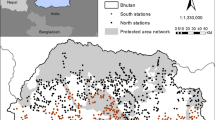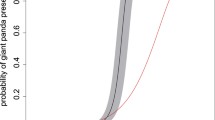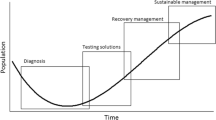Abstract
Changes in wildlife habitat across space and time, and corresponding changes in wildlife space use, are increasingly common phenomenon. It is critical to study and understand these spatio-temporal changes to accurately inform conservation strategy and manage wildlife populations. These changes can be particularly large and complex in areas that face pressure from human development and disturbance but are also under protection and/or restoration regimes. We analyzed changes in space use and habitat suitability of giant pandas in Wolong Nature Reserve, China, over three decades using kernel density, spatio-temporal analysis of moving polygons (STAMP), and MaxEnt methods, and data from three national censuses. Between 2001 and 2012, there was a slight retraction in total range, and more area of significant space use decreases than increases. Habitat suitability varied spatially and temporally, with a 4.1% decrease in average suitability between 1987 and 2001 and a 3.5% increase in average suitability in between 2001 and 2012. Elevation and bamboo were the most important habitat predictors across the three censuses. Human and natural disturbance variables such as distance to household and the distance to landslide variable in the 4th census were also important predictors, and likely also negatively influenced important habitat variables such as bamboo and forest cover. We were able to measure changes in space utilization and habitat suitability over a large time scale, highlighting the achievements and challenges of giant panda conservation. Long-term monitoring of the changes in distribution and habitat of threatened species, and an analysis of the drivers behind these changes such as undergone here, are important to inform the management and conservation of the world’s remaining wildlife populations.




Similar content being viewed by others
References
Bearer S, Linderman M, Huang J et al (2008) Effects of fuelwood collection and timber harvesting on giant panda habitat use. Biological Conservation 141:385–393
Bowman AW, Azzalini A (1997)Applied smoothing techniques for data analysis: the kernel approach with S-Plus illustrations. Oxford University Press, Oxford
Connor T, Hull V, Liu J (2016) Telemetry research on elusive wildlife: a synthesis of studies on giant pandas. Integrative Zoology 11:295
Elith J, Phillips SJ, Hastie T et al (2011) A statistical explanation of MaxEnt for ecologists. Diversity Distributions 17:43–57
Farr TG, Rosen PA, Caro E et al (2007) The shuttle radar topography mission. Rev Geophysics 45:33
Fieberg J (2007) Kernel density estimators of home range: smoothing and the autocorrelation red herring. Ecology 88:1059–1066
Hu JC, Hu J (2003) The study of giant pandas and its progress. J China West Normal University (Natural Sci) 24:253–257 (in Chinese)
Hull V, Xu W, Liu W et al (2011) Evaluating the efficacy of zoning designations for protected area management. Biological Conservation 144:3028–3037
Hull V, Zhang J, Huang J et al (2016) Habitat use and selection by giant pandas. PloS One 11:e0162266
Hull V, Zhang JD, Zhou SQ et al (2015) Space use by endangered giant pandas. J Mammalogy 96:230–236
IUCN (2016) The IUCN red list of threatened species. Version 2016.2. IUCN, Gland, Switzerland
Jenkins CN, Joppa L (2009) Expansion of the global terrestrial protected area system. Biological Conservation 142:2166–2174
Kang DW (2015) Research on the habitat selection of giant pandas. Dissertation, Beijing Forestry University (in Chinese)
Kernohan BJ, Gitzen RA, Millspaugh JJ (2001) Analysis of animal space use and movements. In: Millspaugh JJ, Marzluff JM, eds. Radio tracking and animal populations. Academic Press, San Deigo, CA125–166
Laver PN, Kelly MJ (2008) A critical review of home range studies. J Wildlife Management 72:290–298
Liu D, Huang J, Xie H et al (2014) Effects of Wenchuan earthquake on community Economyin Wolong Nature Reserve. J Sichuan Forestry Sci Technol 35:77–80
Liu J, Hull V, Yang W et al (2016) Pandas and people: coupling human and natural systems for sustainability. Oxford University Press, Oxford
Liu J, Linderman M, Ouyang Z et al (2001) Ecological degradation in protected areas: the case of Wolong Nature Reserve for giant pandas. Science 292:98
Liu JG, Hull V, Luo JY et al (2015) Multiple telecouplings and their complex interrelationships. Ecology Society 20:44
Nelson TA, Duffus DA, Robertson C et al (2008) Spatial-temporal patterns in intra-annual gray whale foraging: characterizing interactions between predators and prey in Clayquot Sound, British Columbia, Canada. Marine Mammal Sci 24:356–370
Ouyang Z, Xu W, Wang X et al (2008) Impact assessment of Wenchuan earthquake on ecosystems. Acta Ecologica Sinica 28:5801–5809
Pearson RG, Raxworthy CJ, Nakamura M et al (2007) ORIGINAL ARTICLE: Predicting species distributions from small numbers of occurrence records: a test case using cryptic geckos in Madagascar. J Biogeography 34:102–117
Phillips SJ, Anderson RP, Schapire RE (2006) Maximum entropy modeling of species geographic distributions. Ecological Modelling 190:231–259
Reid DG, Hu J, Dong S et al (1989) Giant panda Ailuropoda melanoleuca, behaviour and carrying capacity following a bamboo die-off. Biological Conservation 49:85–104
Robertson C, Nelson TA, Boots B et al (2007) STAMP: spatial-temporal analysis of moving polygons. J Geographical Systems 9:207–227
Schaller GB (1993) The last panda. University of Chicago Press, Chicago
Schaller GB, Hu J, Pan W, Zhu J (1985) The giant pandas of Wolong. University of Chicago Press, Chicago
Sichuan Forestry Department (2015) The forth survey report on giant panda of Sichuan. Sichuan science and technology press, Chengdu (in Chinese)
State Forestry Administration(2015) Results of the fourth national survey on the giant panda. [EB/OL].http://www.forestry.gov.cn/main/72/content-742880.html. Accessed 28 February2015(in Chinese)
State Forestry Administration(2006) The third national survey report on the giant panda in China. Science Publishing House, Beijing (in Chinese)
Swets JA (1988) Measuring the accuracy of diagnostic systems. Science 240:1285
Tang X, Jia J, Wang Z et al. (2015) Scheme design and main result analysis of the fourth national survey on giant pandas. Forest Res Management (1):11-16(in Chinese)
Taylor AH, Qin ZS (1988) Regeneration from seed of Sinarundinaria fangiana, a bamboo, in the Wolong Giant panda reserve, Sichuan, China. Am J Botany 75:1065–1073
Taylor AH, Qin ZS (1993) Bamboo regeneration after flowering in the Wolong giant panda reserve, China. Biological Conservation 63:231–234
Tuanmu MN, Vina A, Yang W et al (2016) Effects of payments for ecosystem services on wildlife habitat recovery. Conservation Biology 30:827–835
Viña A, Tuanmu MN, Xu W et al (2010) Range-wide analysis of wildlife habitat: implications for conservation. Biological Conservation 143:1960–1969
Wolong Nature Reserve, Sichuan Normal College (1992) The animal and plant resources and protection of Wolong Nature Reserve. Sichuan Publishing House of Science and Technology, Chengdu (in Chinese)
Xu W, Viña A, Kong L et al (2017) Reassessing the conservation status of the giant panda using remote sensing. Nature Ecology Evolution 1:1635–1638
Xu W, Ouyang Z, Viña A et al (2006) Designing a conservation plan for protecting the habitat for giant pandas in the Qionglai mountain range, China. Diversity and Distributions 12:610–619
Yackulic CB, Sanderson EW, Uriarte M (2011) Anthropogenic and environmental drivers of modern range loss in large mammals. Proceedings National Academy Sci United States Am 108:4024–4029
Yang H, Viña A, Tang Y et al (2017) Range-wide evaluation of wildlife habitat change: a demonstration using Giant pandas. Biological Conservation 213:203–209
Zhang J, Hull V, Huang J et al (2014) Natural recovery and restoration in giant panda habitat after the Wenchuan earthquake. Forest Ecology and Management 319:1–9
Zhang J, Hull V, Ouyang Z et al (2017) Divergent responses of sympatric species to livestock encroachment at fine spatiotemporal scales. Biological Conservation 209:119–129
Zhang J, Hull V, Xu W et al (2011) Impact of the 2008 Wenchuan earthquake on biodiversity and giant panda habitat in Wolong Nature Reserve, China. Ecological Res 26:523–531
Zhou S, Li Z, Huang J et al (2017) Coverage change of ground and canopy layers in Abies-Tsuga forests during the naturalregeneration of Bashania faberi. Chinese J Ecology 36:2403–2411
Zhu J, Li Y (1981) The giant panda. Science Press, Beijing (in Chinese)
Acknowledgements
We would like to thank Dr. Trisalyn Nelson for answering inquiries about methods to determine areas of significant changes in space use. We acknowledge the following sources of funding: the National Natural Science Foundation of China (31572293; 41571517), the talent funding of China West Normal University (17YC358), the Fundamental Research Funds of China West Normal University (17E073, 17E074), and the Key Laboratory of Southwest China Wildlife Resources Conservation, Ministry of Education, China (XNYB17-2).
Author information
Authors and Affiliations
Corresponding authors
Additional information
Responsible editor: Philippe Garrigues
Rights and permissions
About this article
Cite this article
Bai, W., Connor, T., Zhang, J. et al. Long-term distribution and habitat changes of protected wildlife: giant pandas in Wolong Nature Reserve, China. Environ Sci Pollut Res 25, 11400–11408 (2018). https://doi.org/10.1007/s11356-018-1407-6
Received:
Accepted:
Published:
Issue Date:
DOI: https://doi.org/10.1007/s11356-018-1407-6




